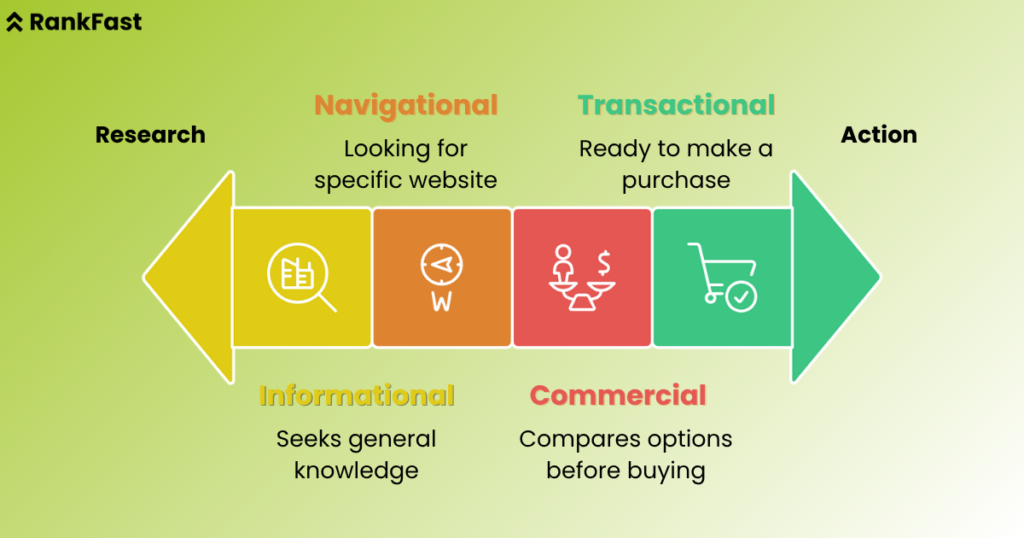Why does your blog never appear on Google even after you write every day?
Many content writers face this. You write, publish, and promote, but still see no traffic. The truth? 96.55% of all pages online receive zero search traffic from Google. Not a little. Zero.
This happens not because the content lacks quality, but because it lacks SEO focus. Writers often ignore what search engines look for. Some don’t check keywords. Others write without structure. Most skip on-page SEO completely. And that’s where the opportunity lies.
This blog will help you fix that. Whether you’re new to SEO or trying to improve, you’ll find clear instructions, proven methods, and examples that make sense.
Let’s break down the SEO for content writers.
Understanding Search Intent Before You Write
Search intent is the purpose behind every search. Before typing a word, you must ask: “What does my reader want when they type this query?”
There are four types of search intent:

- Informational – looking for knowledge (e.g. “how to write SEO content”)
- Navigational – looking for a brand or site (e.g. “Moz blog”)
- Transactional – ready to buy (e.g. “buy grammar checker tool”)
- Commercial – comparing before buying (e.g. “Grammarly vs Hemingway”)
Understanding this helps you choose the right topic, angle, and format. You can’t write a how-to post when the user wants to compare tools. You’ll get traffic, but no results. Writing without search intent is like offering tea to someone asking for coffee.
So, match the content to the searcher’s goal. It increases engagement, keeps readers longer, and helps Google know your page belongs at the top.
Keyword Research SEO for Content Writers
Keyword research is the start of every SEO for content writers. But writers often skip it or do it wrong.
Don’t just pick high-volume keywords. Focus on low competition + high intent phrases. That’s where the win is.
Steps to follow:
- Start with broad topic ideas related to your content
- Use tools like Ubersuggest, Keywords Everywhere, or Google’s auto-suggestions
- Look for long-tail phrases with clear intent
- Check competitor articles for keyword usage
- Group keywords based on topic clusters
Use a mix of primary keywords (your main phrase), secondary keywords (related), and LSI keywords (semantic keywords that help search engines understand your topic).
Example:
If your topic is “SEO content writing”, related keywords may include:
- “how to write SEO content”
- “SEO tips for content writers”
- “on-page SEO checklist for writers”
Avoid keyword stuffing. Instead, place keywords naturally in:
- The title tag
- Meta description
- First 100 words
- Headings (H2, H3)
- Image alt texts
- URL (slug)
With better keyword planning, your article ranks faster and stays longer.
The Real Difference Between Writing for Humans and Algorithms
Writing for readers means being clear, useful, and enjoyable. Writing for algorithms means being structured, optimized, and crawlable. You must do both.
Let’s compare side by side:
| Aspect | Writing for Humans | Writing for Algorithms |
| Tone | Conversational, helpful | Structured, keyword-optimized |
| Format | Flowing paragraphs | Clear subheads, bullet points |
| Goal | Inform, engage, convert | Rank, index, pass SEO tests |
| Keywords | Natural use in flow | Strategic placement in HTML tags |
| Links | Contextual suggestions | Internal and external linking |
| Headings | Storyline progression | Clear keyword-based structure |
Balance is key. If you focus too much on structure, your content reads like a robot. If you ignore structure, Google won’t rank it. Think of SEO as a framework and the writing as the art within it.
On-Page SEO Techniques Every Writer Should Use
You can’t control backlinks or domain authority, but you can control how your page is written. On-page SEO is where writers hold the power.
Let’s look at key elements.
Use proper heading structure
Always use H1 once (usually the title). Then H2 for sections, H3 for sub-sections. Don’t skip levels. This structure helps both readers and search engines navigate your content.
Optimize your meta title and description
Keep titles under 60 characters. Descriptions under 155. Add your target keyword early. Make it clickable, not just descriptive.
Insert keywords naturally
Avoid stuffing. Use primary and secondary keywords in the intro, headings, and conclusion. Sprinkle LSI keywords across the body.
Add internal and external links
Link to related articles on your own site. Also link to authority sources. This builds trust and helps Google understand your topic connections.
Optimize images
Use descriptive file names and alt texts. Compress images to reduce load time. Faster pages improve SEO directly.
Each of these steps adds 1% to your SEO power. Combined, they make the difference between Page 5 and Page 1.
Writing High-Quality Content That Satisfies Algorithms
Good content is not about word count. It’s about covering the topic completely. Google uses NLP (natural language processing) to check if your page answers the user’s query fully.
How to meet this expectation:
- Use topic clusters: Don’t just explain the term, explain related ideas.
- Address common follow-up questions: Use People Also Ask as a guide.
- Use formatting: Bold important terms, use bullet points for clarity.
- Avoid fluff: Every sentence must add value. No fillers.
The better your content depth, the lower the bounce rate. That sends a strong signal to Google. They’ll trust you more and push your content higher.
Tools to Improve SEO Content Writing
Writers don’t need to do SEO blindly. There are tools that show exactly what’s missing.
Here’s a quick list:
- Frase – shows what subtopics to cover based on top-ranking pages
- Surfer SEO – compares your content vs top 10 results
- Grammarly – improves grammar, readability, and clarity
- Hemingway Editor – cuts long sentences and passive voice
- Yoast (for WordPress) – gives real-time SEO tips
- Google Docs with extensions – for direct optimization while writing
Use these tools to refine structure, length, keyword density, and clarity.
Remember, tools don’t write, they assist. You still control the tone and flow.
Balancing Creativity with SEO Structure
You want to write with your voice. But you also want Google to find you. This balance is what separates average content from high-performing content.
Don’t write like a robot
SEO structure should guide your draft, not define your tone. Use metaphors, local examples, and real stories. Just place them inside a smart framework.
Use content outlines
Map your article before writing. Define what each section covers. That keeps both structure and creativity intact. It also improves flow.
Craft irresistible intros
Don’t begin with definitions. Begin with a question, stat, or bold claim. Hook the reader. Then educate.
Write for skim-readers
Most users scan. Use subheads, bullets, and short paragraphs. Bold key terms. Keep your content scannable without losing detail.
Always check readability
Use Hemingway to aim for Grade 6–8 reading level. That doesn’t mean dumbing down, it means clarity.
This balance keeps readers on-page longer. And Google notices that.
Common SEO Mistakes Content Writers Should Avoid
- Writing without a keyword plan
- Ignoring title tags and meta descriptions
- Keyword stuffing
- Weak internal linking
- Not updating outdated articles
- Missing search intent
- Using only generic content without topical depth
- Copy-pasting from competitors
- Writing too much fluff
- Ignoring mobile readability
Fixing these alone can lift your page from nowhere to the top 20.
How to Evaluate and Update Existing Content for SEO
Think of your old blog post as a product on a shelf. If it’s not selling (ranking), it’s losing you money.
Let’s say a blog post took 3 hours to write. At $30/hour, that’s $90 of effort. If it brings 10 visits per month, it’s not paying off.
Here’s how to fix that:
- Pull up old posts with low traffic
- Check if keywords are outdated
- Add missing sections based on “People Also Ask”
- Replace or refresh stats, images, links
- Optimize title, slug, meta, and headings
- Re-submit to Google Search Console
Do this monthly. Rewrites can return 10X ROI with no new content creation.
Final Thoughts
Writing for SEO is not a trick. It’s a structure. And when writers understand it, they write content that performs, not just looks good.
Every blog, guide, or article is a chance to rank. But only if it’s written for humans and algorithms together.
We’ve covered research, structure, tools, mistakes, and more. Now it’s your turn to implement.
If you want expert support, we at Rankfast help content writers and brands produce content that ranks and drives action. Contact us to start building SEO-first content that performs.
FAQs
1. How many keywords should I use in a 1000-word article?
Use one primary keyword and 2–4 secondary ones. Place them naturally in headers, intro, and conclusion.
2. Should every blog have a meta description?
Yes. Meta descriptions improve click-through rate. Include your primary keyword and a call to action.
3. How often should I update blog content?
Review high-performing content every 3–6 months. Refresh old stats, fix broken links, and expand where needed.
4. Do I need SEO tools to write well?
Not mandatory, but tools like Surfer or Frase save time and improve structure. They show what search engines already favor.
5. Is it better to write long-form or short content?
Long-form performs better when detailed. But it must stay relevant and engaging throughout. Avoid padding just for length.
6. Can I rank without backlinks?
Possible for low-competition keywords. But backlinks still help build authority. Focus on content quality and internal links first.

Leave a Reply